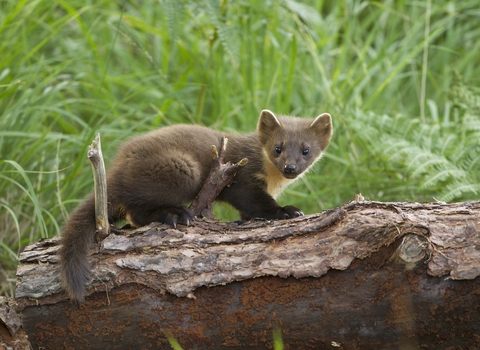
©Mark Hamblin/2020VISION
Pine marten
Largely confined to the north of the UK, the rare pine marten is nocturnal and very hard to spot. However, it can be enticed to visit a peanut-laden birdtable.
Scientific name
Martes martesWhen to see
January to DecemberSpecies information
About
An elusive mustelid, the pine marten is mostly found in the north of the UK, particularly Scotland. It prefers woodland habitats, climbing very well and living in tree holes, old squirrel dreys or even old bird nests. It feeds on small rodents, birds, eggs, insects and fruit, and can even be encouraged to visit birdtables laden with peanuts and raisins. During the summer mating season, they make shrill, cat-like calls. The following spring, the female will have a litter of between one to five kits, which are independent by autumn.How to identify
Mostly chestnut-brown in colour, the pine marten has a characteristic pale yellow 'bib' on its chin and throat. Each pine marten has a uniquely shaped bib, allowing individuals to be identified by the pattern. The pine marten also has a long, bushy tail.Distribution
Mainly found in Scotland, particularly in the Highlands, and Ireland. Populations in northern England and North Wales are fragmented and small. They have also been successfully reintroduced to the Forest of Dean.In our area
The pine marten is making a phenomenal resurgence across Northern Ireland and can now be found in all six counties.
They are also known to den underground in deforested areas in Northern Ireland.
Did you know?
Bilberries, rowan berries and blackberries make up much of a pine marten's summer diet, often resulting in its 'scats' (droppings) turning blue or red in colour. Pine martens regularly leave their scats on forest trails or in prominent places like boulders to mark their territories. When they are fresh, scats may have a slimy appearance due to mucous binding them together. They may contain fur, feathers, bones or seeds.Watch
Pine marten © Russell Savory (https://vimeo.com/366515239/3b94160fd7)
Pine marten © Russell Savory
The pine marten is making a phenomenal resurgence across Northern Ireland and can now be found in all six counties.
They are also known to den underground in deforested areas in Northern Ireland.
